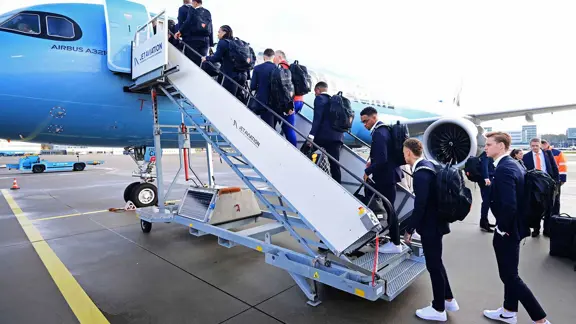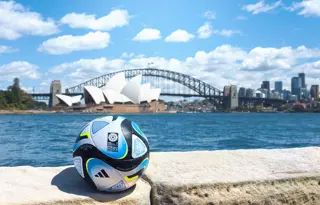News
How does travel fatigue and jet lag affect footballers?

- Prof Christa Janse van Rensburg is Head of Section Sports Medicine (SSM) at the University of Pretoria
- Discusses travel fatigue and jet leg in football, as well as its potential long-term effects
- Involved in the Drake Football Study as a supervisor, Prof Janse van Rensburg also provides updates on the 10-year footballer health study
With the culmination of March’s international window for men’s players and the April international window for women’s players approaching, we are reminded about the extensive travel workload of elite footballers.
Players embarking on cross-continent journeys to link up with their national teams are likely to suffer travel fatigue and jet lag. Travel fatigue comes into play if journeying north-south, south-north or crossing less than three times zone; jet lag, meanwhile, is caused by a mismatch between a person’s normal daily rhythms and crossing three or more time zones. Flying east results in more severe, longer-lasting jet lag.
Whether its players travelling from their clubs in Europe to Asia in order to link up with their national teams or those returning from South America once the window has finished, the multiple, long-distance travel periods of the current international match calendar is once again under the spotlight.
"When we consider their health and wellbeing, footballers would benefit from an international match calendar where they don’t have to travel back and forth long distances," said Prof Christa Janse van Rensburg, Head of the Section Sports Medicine (SSM) at the University of Pretoria and Consultant Rheumatologist at Eugene Marais Hospital.
Following a World Cup that finished in December, the men’s international match calendar for 2023 sees elite players linking up with their national teams in March, June, September, October and November – not to mention continental competitions taking place in June/July for Africa, Asia and Concacaf.
🎥 🚆 𝑯𝒐𝒍𝒂, 𝑼𝒍𝒔𝒂𝒏
— Selección Colombia (@FCFSeleccionCol) March 22, 2023
Hicimos nuestra llegada en tren desde Seúl a la sede del partido del viernes 🆚 🇰🇷#TodosSomosColombia 🇨🇴 pic.twitter.com/S9KSG2iGKn
Colombia travelled to Korea Republic and Japan for two March friendlies
“Rather than footballers travelling to and from multiple continents five or six times in the calendar year, and sometimes only playing two games each window, their health would benefit from cutting down that travel and spending longer periods with their national teams to give their body clocks enough time to adapt and stay adapted,” said Prof Janse van Rensburg, a specialist in the epidemiology of injury and illness in elite and recreational athletes.
“It’s those players who are traveling east across multiple time zones that are more at risk and will take longer to adapt.”
Europe to Asia
While Maya Yoshida was not called up for Japan for their recent internationals against Uruguay and Colombia, the Schalke defender is one of the most-travelled footballers in recent times, having spent the last 13 years playing club football in Europe while journeying to Asia for international qualifiers.
Maya Yoshida Travel: 29 May 2018 - 29 September 2022
- 330,000 kilometres travelled
- 26,000 minutes travelled
- 74 trips crossing time zones
- 8.24 trips around the world
With players enduring such extensive journeys for international matches and crossing multiple time zones so frequently during a season, it begs the question of the long-term physical and mental effects of said travel on those players.
"There has been a lot of research on shift workers who work nights one week and days the next week – and it’s a similar comparison with regards to changing your body clock frequently," said Prof Janse van Rensburg.
"It has been shown in those shift workers that, in the long-term, cardiovascular morbidity is higher; that they are susceptible to metabolic diseases like diabetes. Even cancerous diseases can be increased."
Women’s World Cup travel on horizon
Many national teams will be preparing for a long journey east to Australia and New Zealand for this year’s Women’s World Cup in July.
Prof Janse van Rensburg gives a series of tips players can use to their advantage when travelling east across multiple time zones to mitigate the effects of fatigue and jet lag:
- Pre-travel sleep adaptation: "Where you go to sleep one hour earlier per day for four days."
- Take Melatonin: "A hormone that your brain produces in response to darkness."
- Lenses and Light: "Use amber lenses at a time when you need to block out light. On the other hand, if you arrive and it's dark when you need light depending on your body clock, you can make use of blue light to get that exposure."
- Plan optimal arrival time: "When planning your journey, determine what will be the best time to arrive to get light exposure."

Drake Football Study
Prof Janse van Rensburg is a supervisor and project partner of the Drake Football Study, a ground-breaking 10-year project tracking the physical and mental health of 170 footballers.
2023 is set to yield new insights on the examinations and sub-studies that have taken place on the project, which launched in late 2019.
"One of the core aims of the Drake Football Study is to learn from the players – because there has been a real lack of that," said Prof Janse van Rensburg. "Everyone is looking at injury, surveillance, and return-to-play measures, yet there isn’t actually a lot out there on the general health of the athletes.
"This year we hope to release some of the data analysis in publication format, specifically regarding the men’s study. We’re having a systematic review where we are looking at what has been published to identify further gaps that we then hope to bring into future Drake Football Studies."

The study is giving priority to joint pain in ankles, hips and knees of men’s players, and how it can potentially impact the wellbeing of players in the long-term. Mental health is the early focus involving women’s players, which aims to explore symptoms such as anxiety and depression which are often reported by players.
"What adds real value to the Drake Football Study, is that its findings are relevant and transferrable to other sports," said Prof Janse van Rensburg. "The gynaecological health of women’s athletes especially is an area that needs further exploration, as well as mental health."
The Drake Football Study is seed-funded by The Drake Foundation and supported by Amsterdam University Medical Centers, Mehiläinen (Finland) and Push Sports (The Netherlands).
FIFPRO Chief Medical Officer Prof Dr Vincent Gouttebarge is the project lead together with Prof Dr Gino Kerkhoffs, chair of the Orthopedic Surgery and Sports Medicine department at the Amsterdam University Medical Centres.
